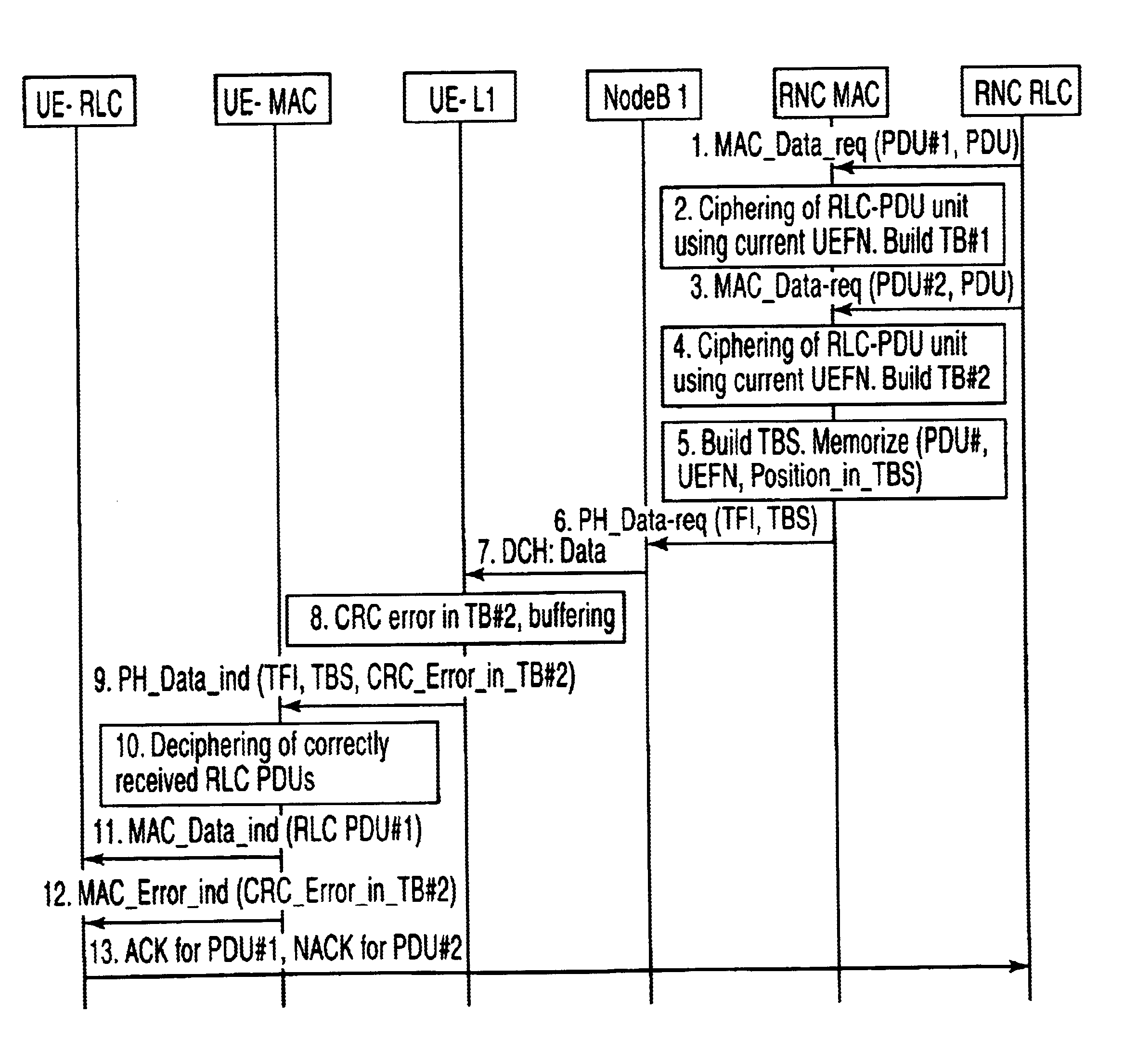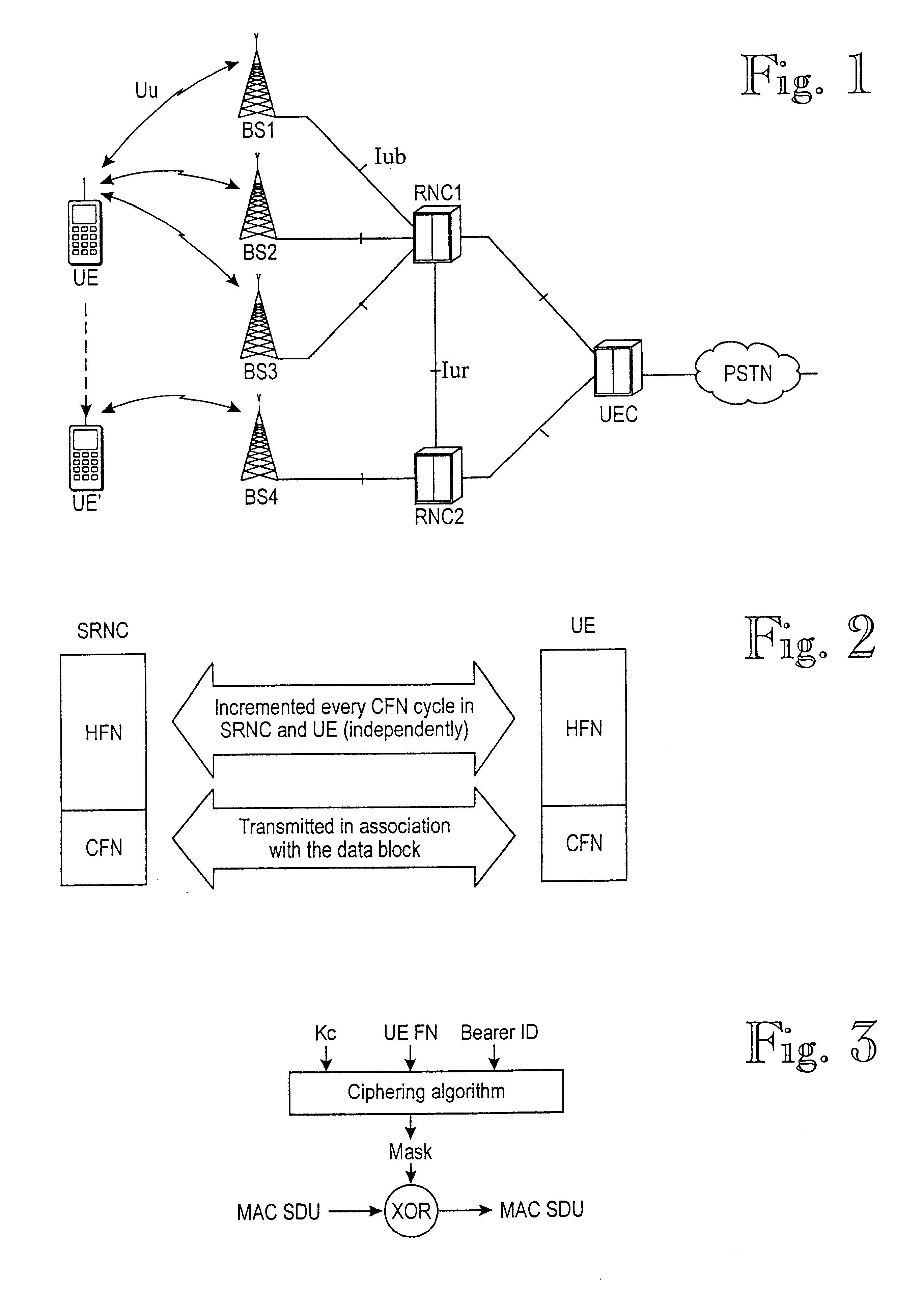The
advantage of the invention is that no additional header information or outband signaling is needed when the packets go through the first (initial) transmission. The additional soft combining information is sent only when it is really needed. This saves transmission resources. This applies both in communications systems in which the frame number is transmitted in the data packets and in communications systems using the connection frame number (CFN)-based
frame synchronization.
is that no additional header information or outband signaling is needed when the packets go through the first (initial) transmission. The additional soft combining information is sent only when it is really needed. This saves transmission resources. This applies both in communications systems in which the frame number is transmitted in the data packets and in communications systems using the connection frame number (CFN)-based
frame synchronization.
The soft combining of several transmissions when erroneous packets are not discarded requires that the transport blocks (e.g. MAC PDUs) to be combined are identical. More particularly, the encoded versions of the block need not be identical, but the
original data used for encoding has to be identical. For example, the MAC
protocol data unit (PDU) contains, in addition to the data, also a MAC header and an RLC header in
third generation mobile communications systems. Soft combining may now require that the retransmitted MAC PDU has to be identical to the originally transmitted MAC PDU, and therefore, also the RLC and MAC headers need to be identical. However, there may be some header information that may change between original transmission and retransmission, such as a
polling bit used to request an
acknowledgement message. In some radio systems a transmission
power level of the next transmission burst is also given in the transmitted packet and this information may change between the original transmission and retranmission(s) of the packet. There is now a conflict between the soft combining requirement of identical packets and the need for changed header information. In an embodiment of the invention, in order to overcome this problem, the information that needs to be changed between the initial transmission and the retransmission(s) of a packet is sent outband with the other outband signaling information indicating the initial version of the packet. Thus, the retransmitted packet can be maintained unchanged and the requirement that packets are identical in soft combining is met. Upon reception of a retransmitted packet, the information which may be subject to change is read from the outband signaling and overrides the corresponding inband information in the received packet. In the initial (first) transmission of the packet, only the inband information is transmitted and used, i.e. the inventive outband signaling information is transmitted only in association with the retransmissions of the packet, if any.
In a preferred embodiment of the invention, a initial transmission of packets is performed using a Connection Frame Number-based synchronization wherein, after initialization of a connection, no frame numbers are transmitted but the
transmitter and
receiver independently count the Connection Frame Number (CFN) (and preferably also an extension thereof, the Hyper Frame Number (HFN)), for each transmitted and received frame, on basis of a connection-specific timing reference which is common to the
transmitter and the
receiver, and to any intermediate node(s), of the connection. Each packet is ciphered in the transmitter and deciphered in the receiver according to the locally counted UEFN of the respective packet. An
automatic repeat request (ARQ) mechanism (such as Type II / III
hybrid ARQ), which includes soft combining of initially transmitted and retransmitted versions of the packet, is provided for retransmissions of erroneous packets. According to the present invention, any packet to be retransmitted is ciphered according to the same UE Frame Number used for ciphering the initially transmitted (first) version of the packet. Further, every time a packet (PDU) is retransmitted, there is outband signaling from a transmitter to a receiver indicating the exact time when the first version of the packet was transmitted, so that it is possible to combine the retransmitted version with the previous version(s) of the packet and also
decipher the combined packet in the receiver. If different encoding is used for transmissions, i.e. the encoded versions of the blocks are not identical, the version of the packet should also be indicated by outband signaling (indicating which decoding should be used).
Alternatively, other ciphering methods can be employed instead of the CFN-based ciphering method in the present invention. Other type of frame
numbering may be also used instead of the CFN. Independently of the ciphering solution or frame
numbering adopted, the invention has the
advantage that there is no need for any outband signaling at the time of the transmission of the first version of a packet.
A second benefit is the possibility to use
Hybrid Type II / III ARQ with CFN-based ciphering, or other frame number-based ciphering, which means that one ciphering method can be used for all types of services. The
advantage of having one single ciphering method is a less
complex system (in particular, there is no need to initialize and maintain separate ciphering counters for each parallel bearers).
 Login to View More
Login to View More  Login to View More
Login to View More 


